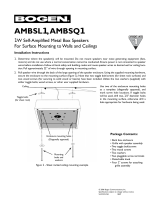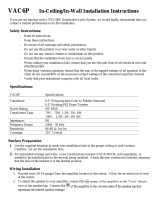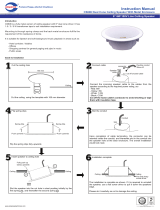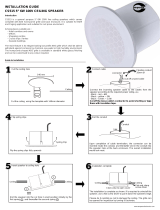50 Spring Street, Ramsey, NJ 07446, U.S.A.
Tel. 201-934-8500, Fax: 201-934-9832, www.bogen.com
Accessories
TBCR (Tile Bridge Support Ring)
The TBCR is a combination tile bridge and support ring that assists in securing the
HFCS1(LP), and in distributing the weight of the speaker in various types of installa-
tions.
CK10 (Cable Kit, 10')
The CK10 is a 10-foot cable with one looped end and an adjustable cable clamp. It
is suitable for use as a safety cable (see Terminal Covers on page 3).
Limited Warranty
Bogen High Fidelity Ceiling Speakers, models HFCS1 and HFCS1LP, are warranted to
be free from defects in material or workmanship for three (3) years from the date of sale
to the original purchaser. Any part of the product covered by this warranty that, with nor-
mal installation and use, becomes defective will be repaired or replaced by Bogen, at our
option, provided the product is shipped insured and prepaid to: Bogen Factory Service
Department, 50 Spring Street, Ramsey, NJ 07446, USA. The product will be returned to
you freight prepaid. This warranty does not extend to any of our products that have been
subjected to abuse, misuse, improper storage, neglect, accident, improper installation or
have been modified or repaired or altered in any manner whatsoever, or where the seri-
al number or date code has been removed or defaced.
THE FOREGOING LIMITED WARRANTY IS BOGEN’S SOLE AND EXCLUSIVE WAR-
RANTYAND THE PURCHASER’S SOLE AND EXCLUSIVE REMEDY. BOGEN MAKES
NO OTHER WARRANTIES OF ANY KIND, EITHER EXPRESS OR IMPLIED, AND ALL
IMPLIED WARRANTIES OF MERCHANTABILITY OR FITNESS FOR A PARTICULAR
PURPOSE ARE HEREBY DISCLAIMED AND EXCLUDED TO THE MAXIMUM
EXTENT ALLOWABLE BY LAW. Bogen’s liability arising out of the manufacture, sale or
supplying of products or their use or disposition, whether based upon warranty, contract,
tort or otherwise, shall be limited to the price of the product. In no event shall Bogen be
liable for special, incidental or consequential damages (including, but not limited to, loss
of profits, loss of data or loss of use damages) arising out of the manufacture, sale or
supplying of products, even if Bogen has been advised of the possibility of such dam-
ages or losses. Some States do not allow the exclusion or limitation of incidental or con-
sequential damages, so the above limitation or exclusion may not apply to you. This war-
ranty gives you specific legal rights, and you may also have other rights which vary from
State to State.
8/10/2004














